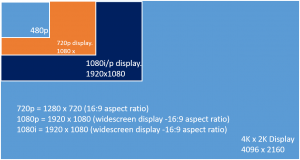Defining Resolution
By John Vellone
In computers, resolution is the number of pixels (individual points of color) contained on a display monitor, expressed in terms of the number of pixels on the horizontal axis and the number on the vertical axis. The sharpness of the image on a display depends on the resolution and the size of the monitor. The same pixel resolution will be sharper on a smaller monitor and gradually lose sharpness on larger monitors because the same number of pixels are being spread out over a larger number of inches.
A given computer display system will have a maximum resolution that depends on its physical ability to focus light (in which case the physical dot size – the dot pitch – matches the pixel size) and usually several lesser resolutions. For example, a display system that supports a maximum resolution of 1280 by 1023 pixels may also support 1024 by 768, 800 by 600, and 640 by 480 resolutions. Note that on a given size monitor, the maximum resolution may offer a sharper image but be spread across a space too small to read well.
Display resolution is not measured in dots per inch as it usually is with printers. However, the resolution and the physical monitor size together do let you determine the pixels per inch. Typically, PC monitors have somewhere between 50 and 100 pixels per inch. For example, a 15-inch VGA (see display modes) monitor has a resolution of 640 pixels along a 12-inch horizontal line or about 53 pixels per inch. A smaller VGA display would have more pixels per inch.
What about the numbers: 720p, 1080i and 1080p?
When high-definition TVs became the norm, manufacturers developed a shorthand to explain their display resolution. The most common numbers you will see are 720p, 1080p and 1080i. As we’ve seen, the “p” and “i” tell you whether it’s a progressive-scan or interlaced-scan display. And these shorthand numbers are sometimes used to describe computer monitors as well, even though in general a monitor is capable of a higher-definition display than a TV. The number always refers to the number of horizontal lines on the display.
- 480p = 640 x 480 (4:3 aspect ratio)
- 480p = 854 x 480 (16:9 aspect ratio)
- 720p = 1280 x 720 (16:9 aspect ratio)
- 1080p = 1920 x 1080 (widescreen display -16:9 aspect ratio)
- 1080i = 1920 x 1080 (widescreen display -16:9 aspect ratio)
Aspect Ratio
- 4:3 aspect ratio resolutions: 640×480, 800×600, 960×720, 1024×768, 1280×960, 1400×1050, 1440×1080 , 1600×1200, 1856×1392, 1920×1440, and 2048×1536.
- 16:10 aspect ratio resolutions: – 1280×800, 1440×900, 1680×1050, 1920×1200 and 2560×1600.
- 16:9 aspect ratio resolutions: 1024×576, 1152×648, 1280×720, 1366×768, 1600×900, 1920×1080, 2560×1440 and 3840×2160
4K Support
The HDMI 1.4 specification adds support for extremely high video resolutions that go far beyond today’s 1080p systems. 4K is shorthand for 4,000 lines wide by 2,000 lines high, or roughly four times the resolution of a 1080p display. The term actually covers two formats, both supported in the HDMI 1.4 specification:
3840 pixels wide by 2160 pixels high
4096 pixels wide by 2160 pixels high

